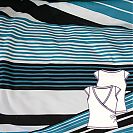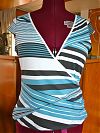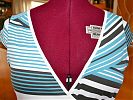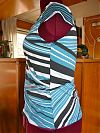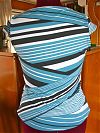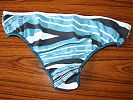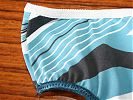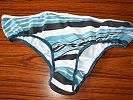I traced out the pattern pieces for this summery surplice knit top from the July 09 issue of KnipMode magazine a few months back, and it’s been hanging on my pattern rack tempting me at every turn. I know it’s silly to be sewing short sleeved, summery tops this late in the season, but that’s what cardigans are for, amiright?
I bought just one metre of this soft lycra jersey from Fabric World on Goldhawk Road for a whopping £3 as I just loved all the different sweeping stripes curving in and over each other. It’s a good fit for a wrap top like this as it creates a bit of an optical illusion, with curves going every which way!
The instructions call for binding the neck edges in bias strips of self fabric, but life’s way too short for that, so I omitted the seam allowance on the top edge and used some white fold over elastic (FOE) instead. I’ve found that this neck treatment works really well for crossover tops as you can stretch the FOE as you apply it and then the neck edge hugs the body when you’re wearing it, preventing gaping. In fact, the neckline looks scandalously low on Susan, but it’s perfectly aceptable on me, though I’d say it’s probably a lot lower than most American women are comfortable with (European women in general are much happier with lower necklines).
Even though I’ve got an overlocker and a coverstitch, I still find the easiest way to apply FOE is to just use the zigzag stitch on my sewing machine, using my left hand to kept the fabric flat (and unstretched!), and using my right to lightly stretch the FOE and keep it sandwiched around the fabric’s edge. It takes a little bit of practice, but once you’ve got the knack, it’s really addictive stuff!
It’s hard to see with the busy print, but there’s some nice gathering where the top layer meets the side seam.
The only thing I don’t like about this top are the small cap sleeves – in hindsight I’d prefer if they were full short sleeves. It’s more attractive on upper arms, IMHO, and you can get a better finish with a full sleeve. Here, the underarm edge must be turned under and coverstitched (or twin needle stitched), which looks slightly odd where the coverstitching meets the sleeve.
And finally, here’s the back view, which is pretty plain.
Now, remember how I said I had one metre of fabric? Well, with some canny layout magic, I was not only able to make this top, but also a pair of pants AND one layer of a balaclava for my 4 year old neighbour!
This is a TNT thong pattern from the January 2008 KnipMode, but when I was cutting out the pieces, I assumed I’d use the same white FOE on the top edge, then use a turn-under picot edged lingerie elastic for the leg edges. Only when I looked through my elastic stash, I realised I only had FOE left, so I just used some dark turquoise FOE on the leg edges instead.
Realise my mistake yet? I forgot to trim off the seam allowances on the leg openings before applying the FOE (which you apply without any seam allowances since it just wraps around the edge)! So my thong is rather a bit too wide in the back. D’oh. I hope it’s not too uncomfortable, as the fabric is just lovely! (Note to self – must buy more picot edged lingerie elastic for impromptu pants sewing!)
Coming up next – that sheer tartan overblouse from last November’s issue of BWOF!

